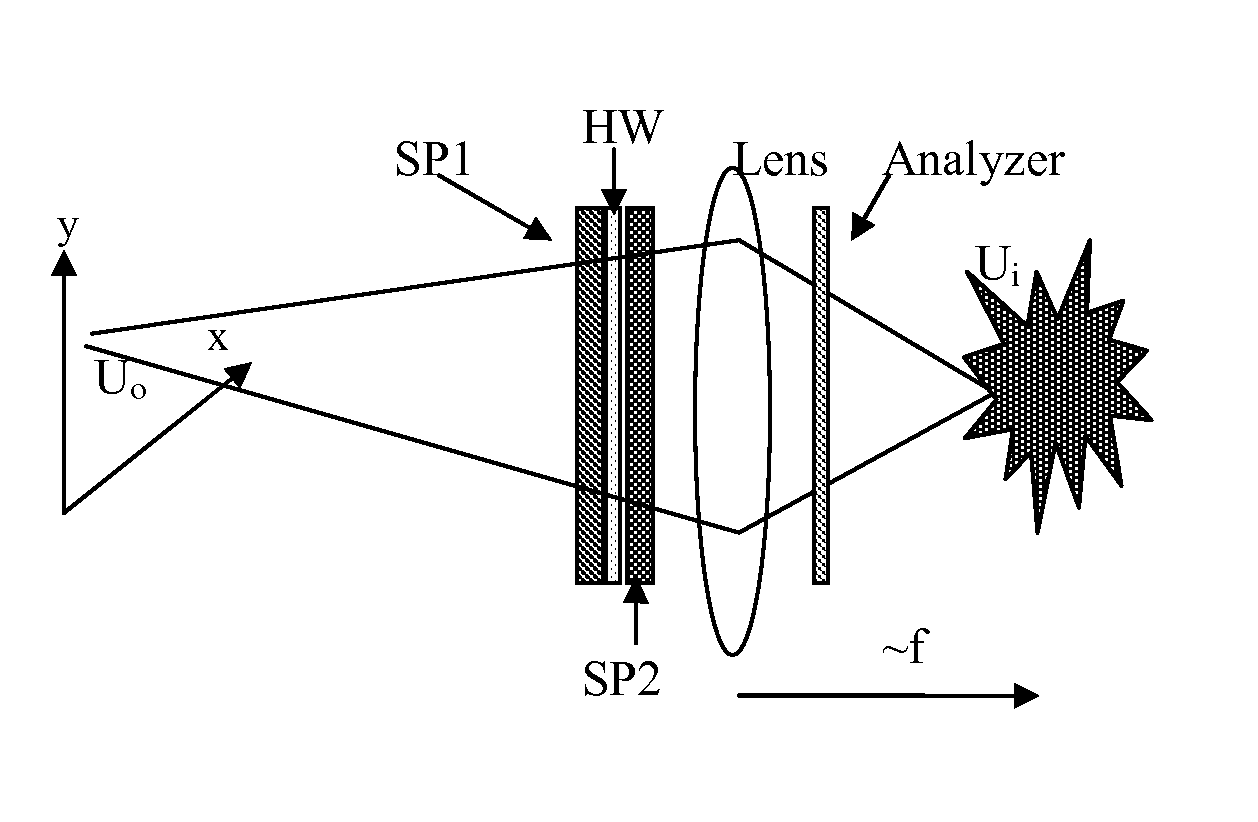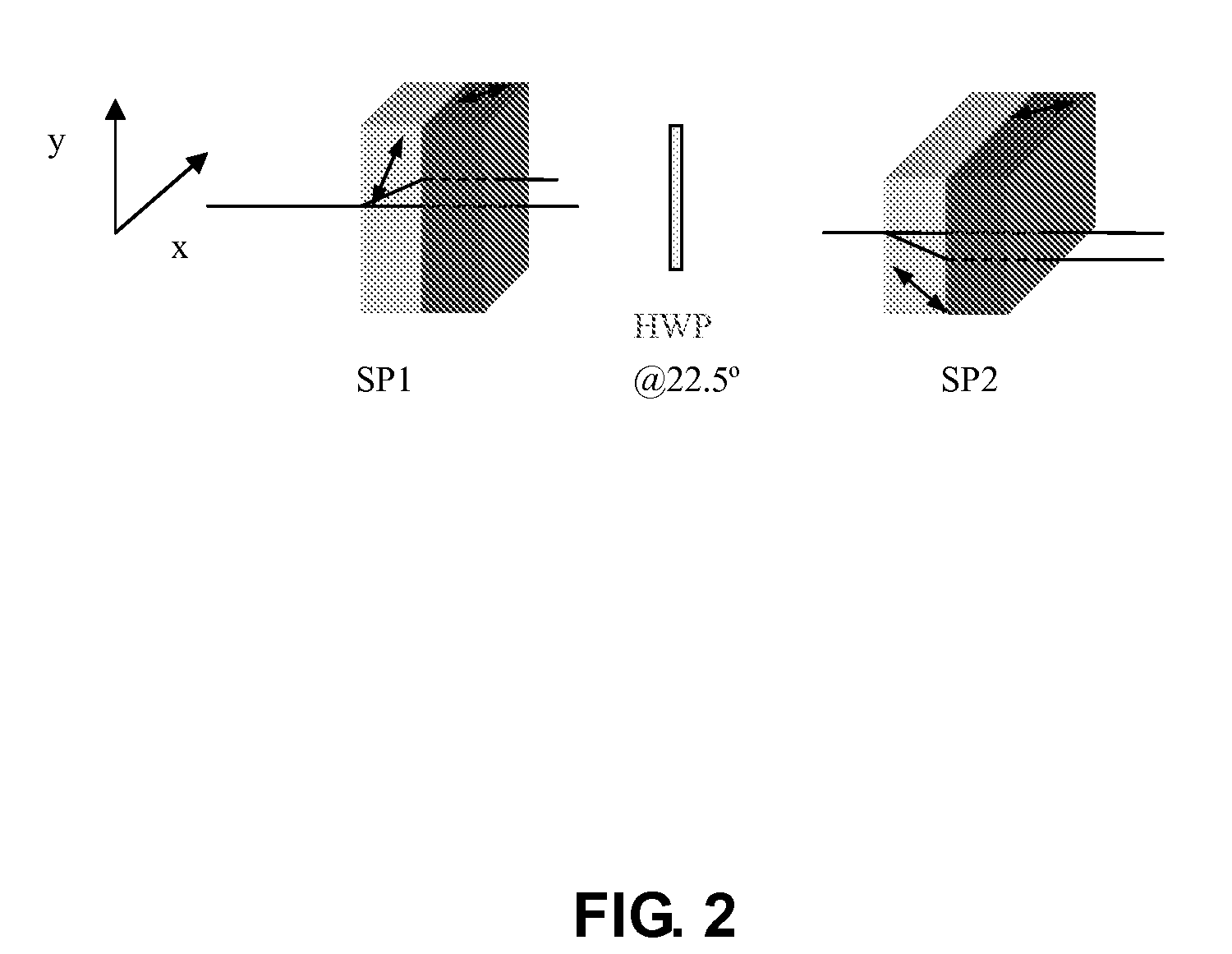Compact snapshot polarimetry camera
a polarimetry and camera technology, applied in the field of compact snapshot polarimetry camera, can solve the problems of increasing the risk of breakage, adding mechanical noise, and adding complexity to the instrumen
- Summary
- Abstract
- Description
- Claims
- Application Information
AI Technical Summary
Benefits of technology
Problems solved by technology
Method used
Image
Examples
example 1
[0047]To simulate the system, the above mentioned parameters were inserted into Zemax ray tracing software (see zemax.com) with a 5 mm diameter aperture. The image spot diagrams and ray shearing diagrams from this simulation can be seen in FIG. 6. Two different field points were sampled and the object was 1 m distant. The image quality looks impressive for both the on-axis and off-axis field points, with the aberrated spot size close to the diffraction limit. This result shows the SPs do not introduce excessive aberrations when imaging a finite conjugate object. In FIG. 6(b), the on-axis ray shearing diagrams are consistent with expectation, i.e., four rays are sheared equally and diagonally with values of √{square root over (2)}Δ=113 μm. Conversely in the off-axis case, however, the four rays are not sheared ideally and their shearing distances are not equal to each other. Both issues are due to the asymmetry of the SP itself. This deviation worsens form on-axis to off-ax...
example 2
Camera-Scale System
[0048]A system with commercially available elements, all of which were one-inch in diameter and mounted independently was built. The SPs were manufactured by Karl Lambrecht Inc. A 75 mm focal-length lens was used, extending the total length by a factor of 15 from the imaging system. This parameter can be changed, as known in the art. A photo of the actual polarimeter built is shown in FIG. 5.
[0049]FIG. 7(a) shows a raw image obtained by the polarimetry camera and FIG. 7(b) shows the reconstructed Stokes images. A uniform polarized image was formed with a linear polarizer at 22.5° (S1=0.707, S2=0.707, S3=0) was used as a reference to calibrate the system. The camera's viewing angle was about 60 degrees with respect to the ground and the object, a car, was about 30 m away. In FIG. 7(a), the clear fringes seen across the image indicates the existence of polarization signals. This is due to the skewed sun-object-camera angle and less scattering surfaces that are insid...
example 3
Miniature System
[0050]Following the theory and teachings herein, a miniaturized system can be built. A miniature system can modify a cell phone camera with f=5 mm and pixel spacing 4.75 μm, λ=0.55 μm, and Ω=4 pixels / fringe. The required thickness t then equals 1.54 mm and the total length of the polarimeter is shorter than 1.5 cm. The elements can be glued together using appropriate glue and simply placed or glued in front of a miniature camera such as a cell phone camera.
[0051]Other size systems can be made using the teachings described herein. The systems include the necessary optics and light guiding as required for a given application. For example, all systems may include a computer having the necessary program for the analysis of the waveforms.
PUM
 Login to View More
Login to View More Abstract
Description
Claims
Application Information
 Login to View More
Login to View More - R&D
- Intellectual Property
- Life Sciences
- Materials
- Tech Scout
- Unparalleled Data Quality
- Higher Quality Content
- 60% Fewer Hallucinations
Browse by: Latest US Patents, China's latest patents, Technical Efficacy Thesaurus, Application Domain, Technology Topic, Popular Technical Reports.
© 2025 PatSnap. All rights reserved.Legal|Privacy policy|Modern Slavery Act Transparency Statement|Sitemap|About US| Contact US: help@patsnap.com



